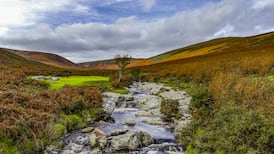A passing cyclist recently spotted this distressed bird outside my gate, having been struck by a car while feasting on a pigeon. Apart from the large visible tags, the bird was also ringed and I was able to pass the codes to the relevant authorities via Birdwatch Ireland. We also notified an OPW ranger who collected the bird from the garden. I am told it’s a kite. These are common in the area and very impressive in flight. I hope he survives. Nigel Murtagh
Well, it won’t be your fault if it doesn’t; you did all the right things. Red kites were once a common bird of prey in Ireland but became extinct as a breeding bird by the 19th century due to poisoning and shooting. They were reintroduced to Wicklow in 2007, to Co Down in 2008 and to Fingal in 2011. They are breeding here now. Nestlings are ringed and given wing tags that allow them to be identified in flight. As well as catching their own prey, they will feed on dead rats, thus accumulating rodenticides and coming into contact with roadkill. This exposes them to speeding cars.

This fellow was about an inch long and very thin. It had bright yellow legs and a yellow and brown abdomen. It crawled across my foot as I sat earlier in Mullaghmore, Co Sligo. We wondered if he was some kind of Japanese hornet. Úna Smart
What on Earth makes you think there would be a Japanese hornet in Mullaghmore? Neither the Japanese hornet nor the larger sub-species, the Asian hornet, are seen in Ireland or Britain. The creature you have just slandered is a harmless ichneumon, Amblyteles armatorius. Harmless that is, unless you are a caterpillar on which it lays an egg, as the emerging larva will eat the caterpillar alive from the inside out.
RM Block

This comma butterfly landed on my windowpane on a sunny day in mid-July. I have never seen this species in these parts before. P McGinty, Balbriggan
Comma butterflies are indeed a new addition to our butterfly fauna. They were first recorded here in Wexford’s Raven Nature Reserve in 2000 and were breeding in Carlow by 2011. They have now spread widely due to a warming climate and have been recorded in every county except Donegal and Leitrim. Caterpillars feed on nettles and there are two broods per year. It overwinters as an adult, emerging to breed the following spring.

I found this on the shore near Claggan on Clew Bay in Mayo. Is it a fossilised coral? The rock looks like limestone. Frank Folan, Ballyvaughan
This is a fine example of a cluster of fossilised crinoid stems in carboniferous limestone, which was formed 350 million years ago. Crinoids are sea creatures that lived in the shallow tropical sea waters covering Ireland at the time. They were in the group of sea animals called echinoderms – their modern relatives are sea cucumbers and sea lilies. When these crinoids died they became embedded in the lime mud, which solidified into the limestone rocks we find in parts of the Clew Bay area and more famously in the Burren.

This little creature is round and a lovely chestnut colour and was sitting on the road by the Barrow Estuary here in Ballinlaw, Co Kilkenny. According to the unsolicited suggestions I keep getting from the artificial [so-called] intelligence on my phone, it is either a bog lemming from Canada or a Californian vole. Hmm! Don’t think so! Cad é? Anita Fennelly, Slieverue, Kilkenny
Glad you have the wit to doubt this rubbish. It’s a bank vole, which is a common small mammal here.
Please submit your nature query or observation, ideally with a photo and location, via irishtimes.com/eyeonnature or by email to weekend@irishtimes.com













